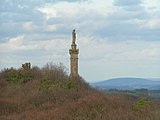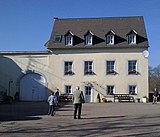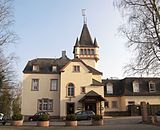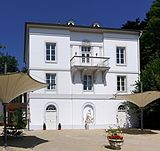List of cultural monuments in Trier / district
District
| designation | location | Construction year | description | image |
|---|---|---|---|---|
| Maria-Hilf chapel | on the slope below the Mariensäule, west of the Westfriedhof Lage |
1870-84 | Catholic Maria-Hilf-Chapel; small neo-Gothic chapel, 1868, architect Claus Arendt, Luxembourg; Station path of the seven pains Mariae, neo-Gothic shrines, clay reliefs with Nazarene style, 1870–84 | |
| Marian column | on the slope edge of the Markusberg not far from the road to the Markusberg Lage district |
1859-66 | tower with a plinth, on the baluster-lined viewing platform above an octagonal base statue of the Virgin Mary, 1859–66, design by architects Ch. W. Schmidt and JP Schmidt, Maria Immaculata based on sketches by G. Renn, Speyer; shaping the landscape |

|
| Kockelsberg manor | north of Pallien in the forest location |
1798 | two wings of the former three-sided complex, residential building marked 1798 |

|
| Schusterskreuz | in Trier's Forest, west of Stubenbergs, south of the A64, many at the meeting of forest roads situated location |
1745 | Shaft cross on an altar-like base, shell niche with an almost fully plastic Pietà, inscribed 1745 | |
| Sievenicher Hof | Located in the west of the urban area, in open countryside on the way towards Aach location |
late 18th century | Group of commercial and residential buildings; older residential building from the late 18th century, expanded by a service wing and brought together under one roof; Younger house with a half-hipped roof on one side, 19th century; Administrator's house, one-storey historicist half-hipped roof building, marked 1900, architect AJ Mayer, with furnishings; Kuhstall 1905, also by Mayer, preserved unchanged | |
| Kurhaus Kockelsberg | north of Pallien on the Kockelsberg location |
1890/91, 1924 | Castle-like, nested building around a four-storey tower with four guard houses 1890/91, architect K. Th. Schmitt, Frankfurt / M. (Execution by Eberhard Lamberty), extended in 1924; shaping the landscape |

|
| Villa Weißhaus | north of Pallien on the slope edge above the Moselle location |
1823 | Country house; three-storey classicist hipped roof building, 1823; Associated with the orangery from 1863, remnants of the cast iron garden fence, fountain, wrought iron gate, obelisk marked 1879 |

|
| Holy House | west of Markusberg location |
in the middle of the 19th century | Holy house; in the Pietà niche, probably from the middle of the 19th century |
literature
- Patrick Ostermann (arrangement): City of Trier. Old town. (= Cultural monuments in Rhineland-Palatinate. Monument topography Federal Republic of Germany . Volume 17.1 ). Wernersche Verlagsgesellschaft, Worms 2001, ISBN 3-88462-171-8 .
- Ulrike Weber (arrangement): City of Trier. City expansion and districts. (= Cultural monuments in Rhineland-Palatinate. Monument topography Federal Republic of Germany . Volume 17.2 ). Wernersche Verlagsgesellschaft, Worms 2009, ISBN 978-3-88462-275-9 .
- General Directorate for Cultural Heritage Rhineland-Palatinate (publisher): Informational directory of cultural monuments of the district-free city of Trier . Mainz 2018 ( PDF; 4.9 MB [accessed on January 23, 2018]).
